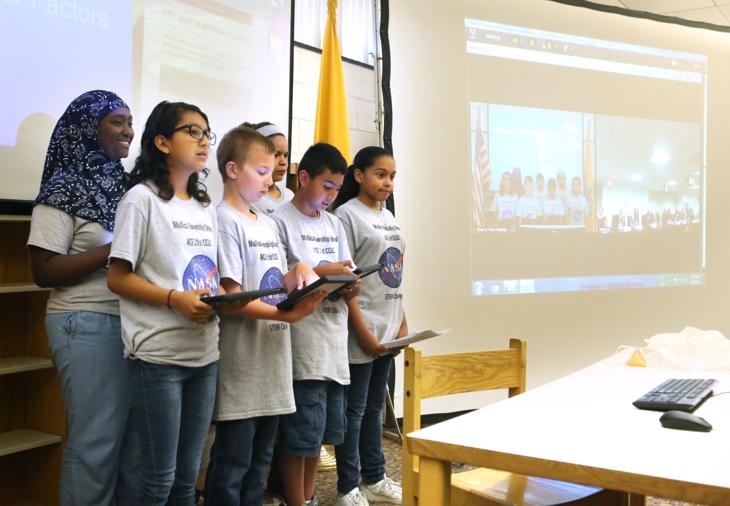
Samurai Turner, 12,left background Milagros Esquivel 12 , Eric Stollenwerk 12 Jared Jacobo 12 and Aliyah's Roberts 11, right students of Mullica Middle School take part in making presentation for NASA staff during a virtual showcase Thursday, May 28, 2015. Mullica Middle School is one of only 7 schools in the nation to make it this far in a contest about solving engineering problems re a mission to Mars.
MULLICA TOWNSHIP — Scientists have a great appreciation for mistakes.
That was clear from the remarks
of leaders from the National Aeronautics and Space Administration and
U.S. Department of Education during an Internet showcase of students’
solutions to engineering problems Thursday.
Mullica Township Middle School’s
team of sixth-graders was one of seven chosen to participate from 125
nationwide, based on creativity, engineering, student data collection
and analysis.
The Mullica students described
their mistakes in trying to slow down a Mars lander. All the teams had
made errors and learned from them.
“Failure is not bad, it just
helps you figure out which place to go,” Ellen Lettvin, Robert Noyce
Fellow in Informal STEM Learning in the DOE’s Office of Innovation and
Improvement, told one team. “I like you made that very clear.”
The Mullica team of Lauren
Cooper, 12; Milagros Esquivel, 12; Gavin Henry, 11; Jared Jacobo, 12;
Aliyahna Roberts, 11; Eric Stollenwerk, 12; and Samirah Turner, 12,
combined a parachute with an X-sail below it to add stability and drag.
The team redesigned it after the parachute didn’t inflate fully and the flight was unstable, Eric said in the presentation.
But some of the changes, like cutting too large a vent hole in the parachute, created more problems, he said.
“These were hard problems,” said astronaut Catherine “Cady” Coleman. “It takes a lot of patience.”
The student teams were all from
21st Century Community Learning Center after-school programs. They gave
presentations on their projects and answered questions from experts via
cameras and iPhones over the Internet.
The other teams in the final
seven were from Providence, Rhode Island; Pontiac, Michigan; Soldiers
Grove, Wisconsin; Caney, Oklahoma; Roanoke, Virginia; and Frenchtown,
Montana.
One team focused on creating a
game on Mars, two designed pressure suits to protect marshmallow
astronauts, one designed a way to pack for space travel and one designed
a crew exploration vehicle.
http://www.pressofatlanticcity.com/communities/hammonton_egg-harbor-city/mullica-students-display-problem-solving-skills-for-nasa/article_66b46622-058e-11e5-a936-cf3143f586a9.html?mode=image&photo=1
The Oklahoma team participated even though their hometown was hit by a tornado May 25, organizers said.
While speaking on camera, one Oklahoma presenter yawned widely, eliciting giggles from adults and students.
“They’re still just kids,” said
science teacher Barbara Rheault, who was recruited as the adviser for
the project by the school’s academic and community enrichment director,
Margaret Goodher.
“I told them yesterday, I keep forgetting you are just 11 or 12 years old,” Rheault said.
Rheault said two teams of
students participated in Mullica, and both teams did well and presented
their parachute systems to the Board of Education this week.
The scientists also focused on
teams’ honesty in describing how difficult engineering problems can be
and on the importance of teamwork.
“People are good at different
things,” said astronaut Coleman. “Physics is difficult for me, but I use
it every day and it doesn’t matter if I like it or it’s hard. I have to
swallow my pride and ask for help.”
Science isn’t easy, even for those who love it, said Roosevelt Y. Johnson, deputy associate administrator of education at NASA.
“Don’t be afraid of things that
are hard. Science to me is exciting and interesting because it was
hard,” said Johnson, adding that after years of work it became less
difficult and more fun.
For more on NASA STEM Design Challenges, visit y4y.ed.gov/stemchallenge/NASA
Contact: 609-272-7219
@MichelleBPost on Twitter
More photos and video at http://www.pressofatlanticcity.com/communities/hammonton_egg-harbor-city/mullica-students-display-problem-solving-skills-for-nasa/article_66b46622-058e-11e5-a936-cf3143f586a9.html?mode=image&photo=1


No comments:
Post a Comment